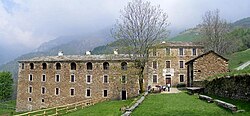world.wikisort.org - Italy
Sordevolo is a comune (municipality) in the Province of Biella in the Italian region Piedmont, located about 60 kilometres (37 mi) northeast of Turin and about 7 kilometres (4 mi) west of Biella.
Sordevolo | |
|---|---|
Comune | |
| Comune di Sordevolo | |
 Trappist monastery of Sordevolo. | |
 Coat of arms | |
Location of Sordevolo  | |
 Sordevolo Location of Sordevolo in Italy  Sordevolo Sordevolo (Piedmont) | |
| Coordinates: 45°34′N 7°59′E | |
| Country | Italy |
| Region | Piedmont |
| Province | Biella (BI) |
| Government | |
| • Mayor | Alberto Monticone |
| Area | |
| • Total | 13.8 km2 (5.3 sq mi) |
| Elevation | 627 m (2,057 ft) |
| Population (31 December 2010)[2] | |
| • Total | 1,334 |
| • Density | 97/km2 (250/sq mi) |
| Demonym | Sordevolesi |
| Time zone | UTC+1 (CET) |
| • Summer (DST) | UTC+2 (CEST) |
| Postal code | 13817 |
| Dialing code | 015 |
Sordevolo borders the following municipalities: Biella, Graglia, Muzzano, Occhieppo Superiore, Pollone, Lillianes. The village is located in the Elvo Valley, a natural land at the foot of the Alps, in the middle of a religious and cultural area. Sordevolo can be considered a place of faith and popular devotion, whose widest expressions are the seven churches (and up to the last century three brotherhoods, too), and the Passion Play, while in the past were the Last Judgement Play in the 19th century and St. Augustine drama, were performed in 1777. Sordevolo is also historically bound to the textile industry that influenced the life of the village for centuries.
La Passione
This section contains content that is written like an advertisement. (May 2022) |
Every five years, La Passione (the Passion Play) is organized by the Associazione Teatro Popolare di Sordevolo, involving the community of Sordevolo. The play has been held since 1816 and involves approximately 400 actors and 300 crew. Forty shows are performed over 100 days.

The performance in 2015 was patroned by the Ministry of Cultural Heritage and Activities from the Papal Committee for the Cultural Heritage of the Church.
The script is a text in verses that dates to the end of the 15th century, written by Giuliano Dati, chaplain of the church of the Forty Saints Martyrs in Trastevere, Rome. In 1539 during the Reformation, Pope Paul III banned the play. A copy of the original roman manuscript printed in Turin in 1728, now exhibited and preserved in the Museum of the Passion, inside the Church of Santa Marta, one of the churches of the village.


References
- "Superficie di Comuni Province e Regioni italiane al 9 ottobre 2011". Italian National Institute of Statistics. Retrieved 16 March 2019.
- All demographics and other statistics: Italian statistical institute Istat.
На других языках
[de] Sordevolo
Sordevolo ist eine Gemeinde mit 1342 Einwohnern (Stand 31. Dezember 2019) in der italienischen Provinz Biella (BI), Region Piemont.- [en] Sordevolo
[es] Sordevolo
Sordevolo es una localidad y comune italiana de la provincia de Biella, región de Piamonte, con 1.341 habitantes.[ru] Сордеволо
Сордеволо (итал. Sordevolo) — коммуна в Италии, располагается в регионе Пьемонт, в провинции Бьелла.Другой контент может иметь иную лицензию. Перед использованием материалов сайта WikiSort.org внимательно изучите правила лицензирования конкретных элементов наполнения сайта.
WikiSort.org - проект по пересортировке и дополнению контента Википедии
